I dumped the only PAL from a Gunbird 2 PCB.Original device was a secured PALCE16V8H marked ‘PS5-1’ @U18.Dump has been successfully tested onto a GAL16V8 targeting device.
Truxton repair log #2
Some days ago I had this Truxton PCB on the bench:
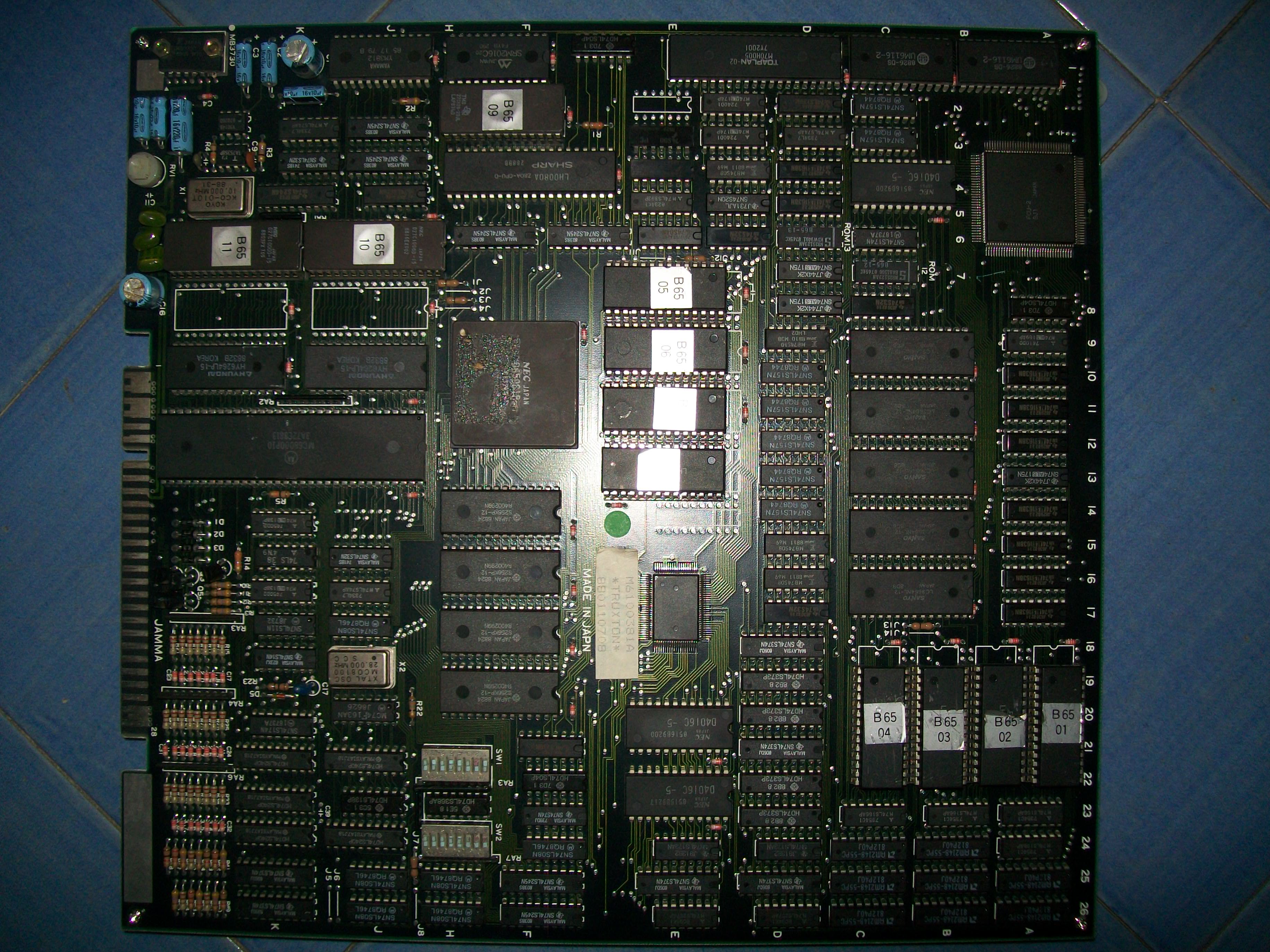
Game had wrong colors on some background/foreground objects, like title screen
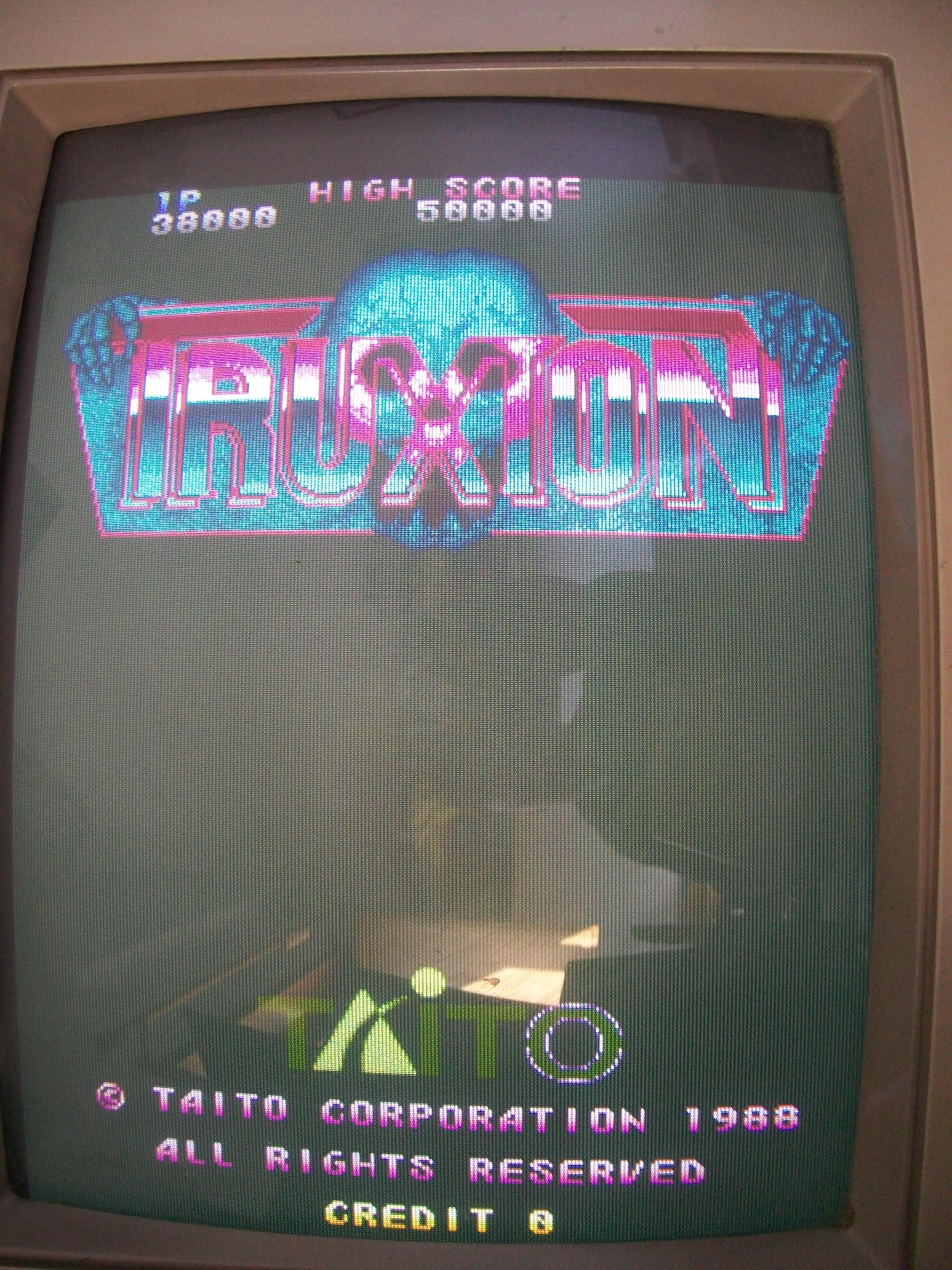
This part of graphics is generated by a ceramic PGA custom marked ‘NEC D65081R’ which addresses four 1Mbit MASK ROM and read/write data from/to four 62256 static RAMs:
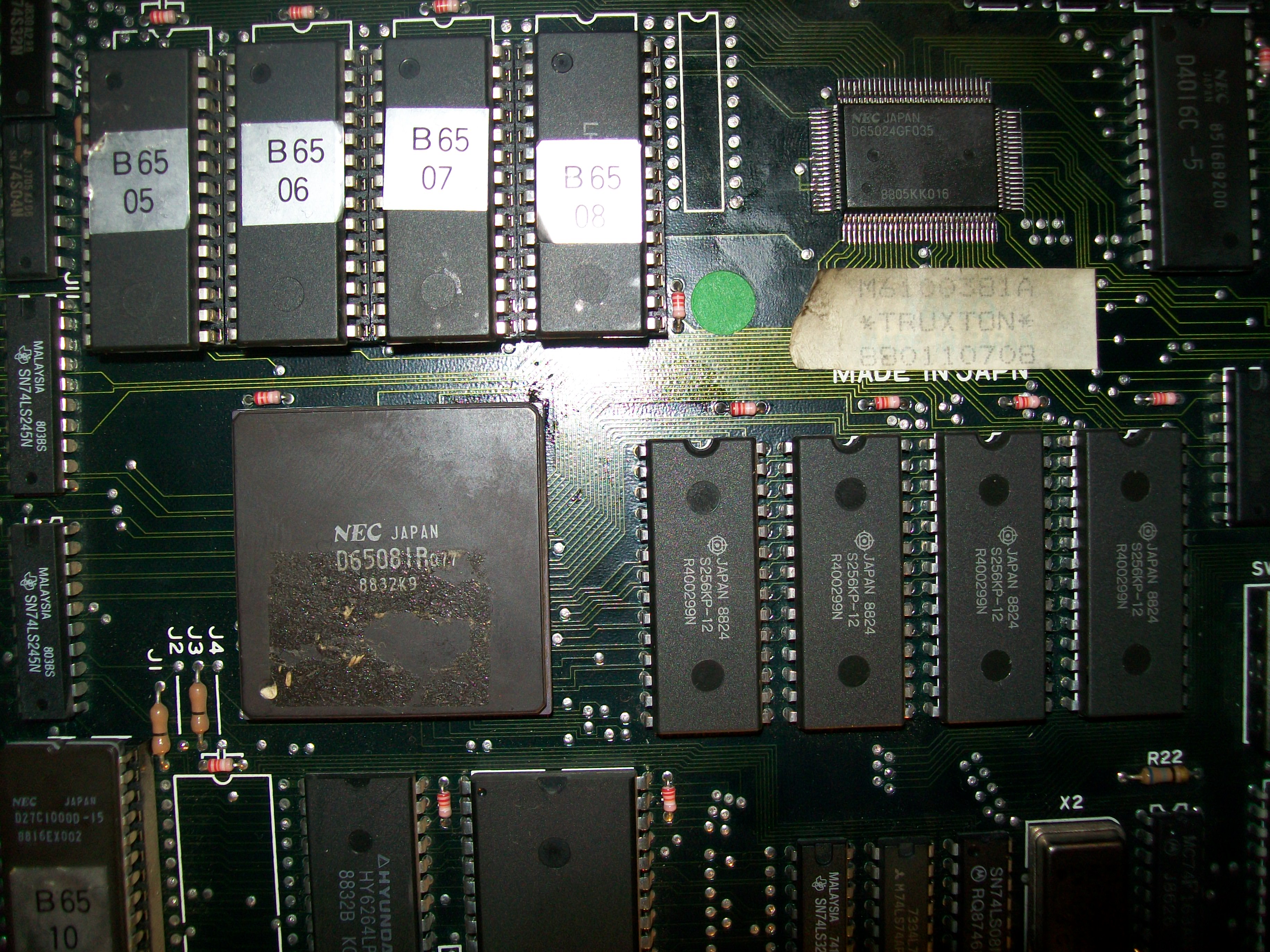
Address bus is daisy-chained between the custom, the four MASK ROMs and the four RAMs, all was in order here.Custom receives data from MASK ROMs and transmits/receives to/from from RAMs on two different bus.When I went to check connections, I found no continuity between pin 17 (D5) of the RAM @18F and the custom.Here is where trace from pin of the RAM goes under the custom (picture taken with a USB microscope)
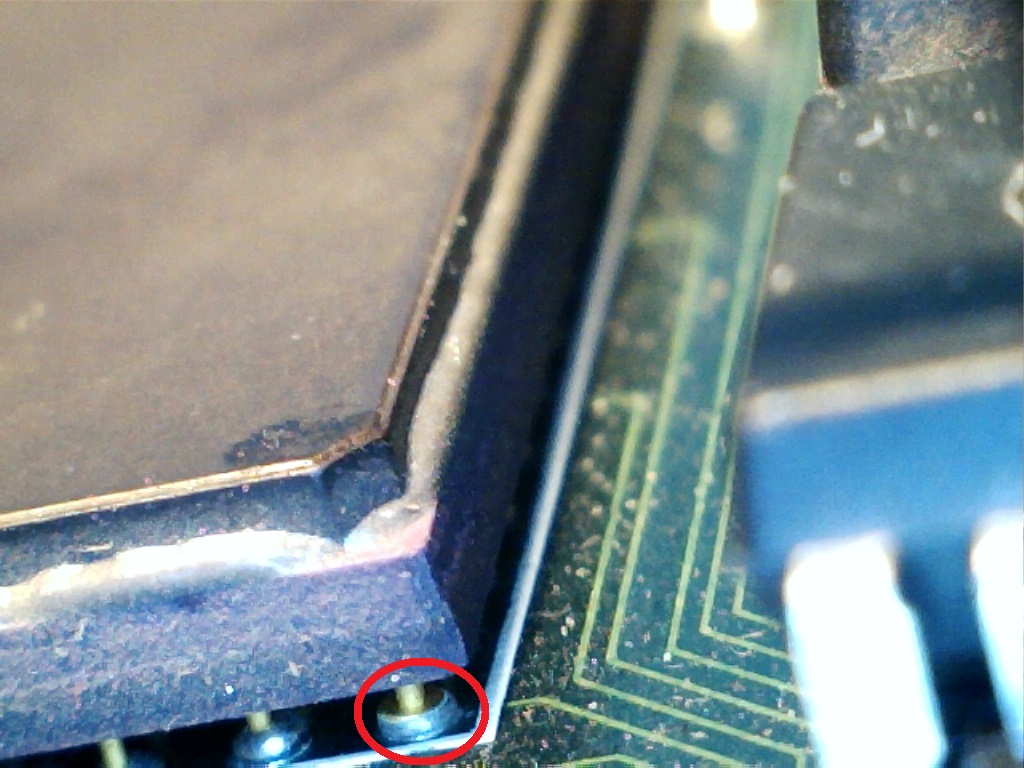
Infact, if I pressed the custom in this corner, the fault went away.I simply reflowed this dry joint and all came back to normality.
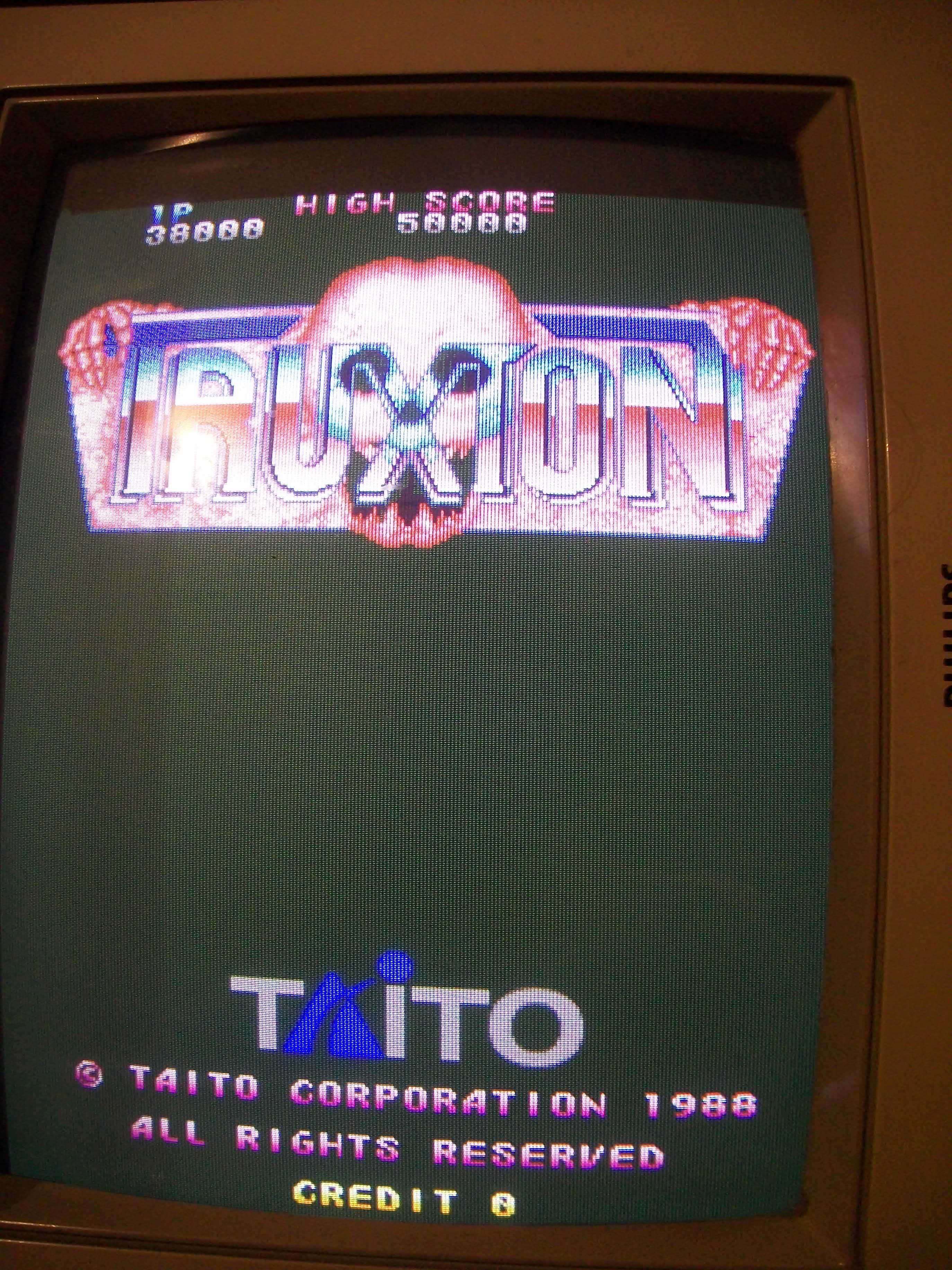
Big Fight and Ninja Emaki PAL dumps added
Today I dumped two PALs from a Big Fight and Ninja Emaki PCBs.In the first board, device was a secured PEEL18CV8 located on daughterboard @IC56, I was able to fit equations in a GAL18V10 targeting device.In the latter board, device was a secured PAL14H4 @10F on CPU board which I successfully reversed onto a GAL16V8.Both boards had also other PLD devices but all set as registered so not dumpable.
Big Fight – Big Trouble In The Atlantic Ocean repair log
Got this rare Big Fight – Big Trouble In The Atlantic Ocean (this is the full title) PCB for a repair :
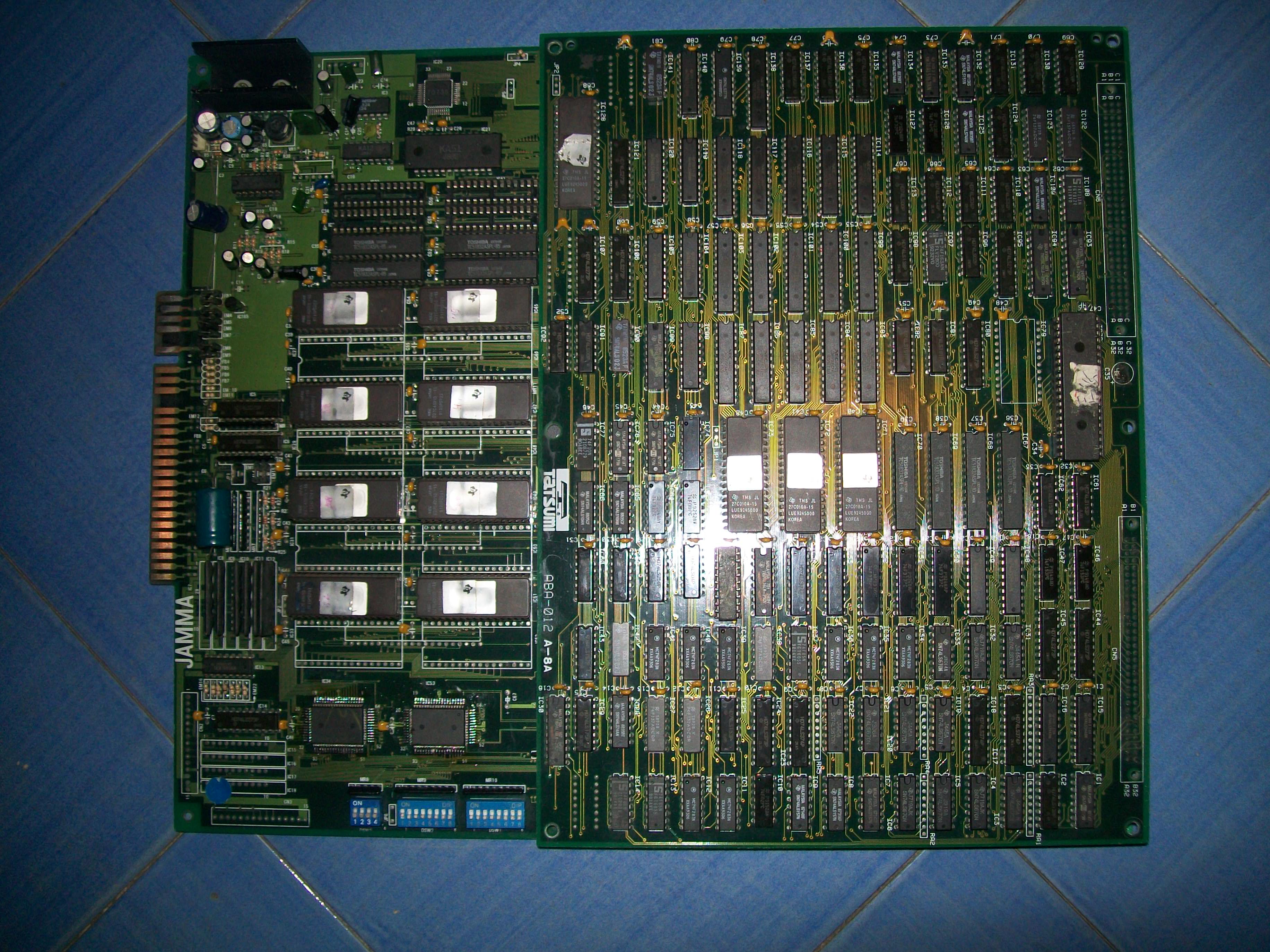
For the uninitiated game a beat ’em up which resembls Final Fight but it features also a versus mode.It was developed and published by the obscure Tatsumi manufacturer in 1992, it was one of their last arcade game before focusing on novelty sticker printing business.
The board was completely dead, I got only a black screen.The hardware is complex : two 68000 CPU, a large PGA sprites custom IC, many PLDs, lots of RAMs.Here is picture with the daughterboard removed:
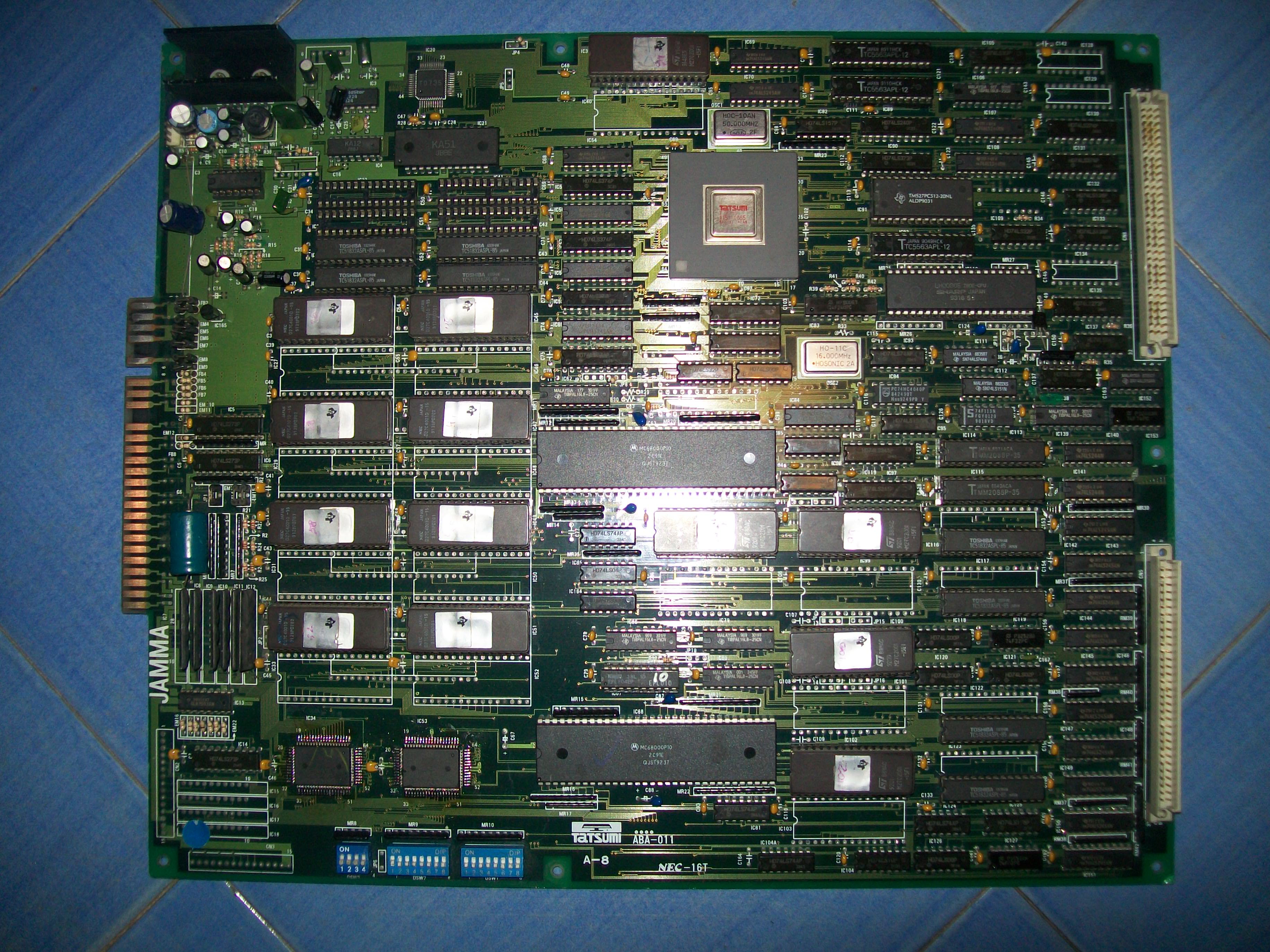
Probing the two 68000 revealed no clock, master clock is generated by a 50MHz oscillator and then divided by 4 in order to route a signal of 12MHz to both CPUs:
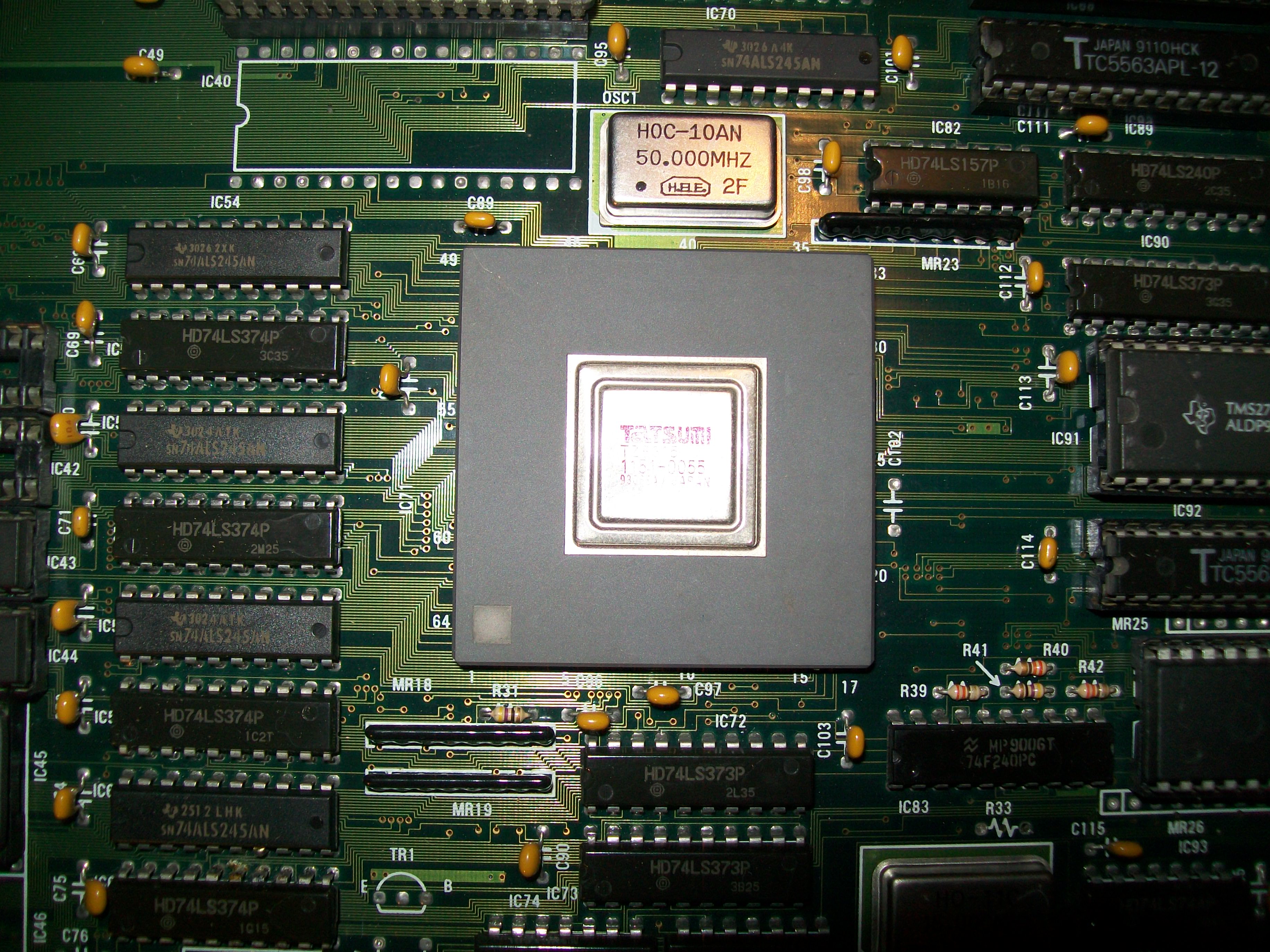
The output of the oscillator was dead, stuck at 1.64V :
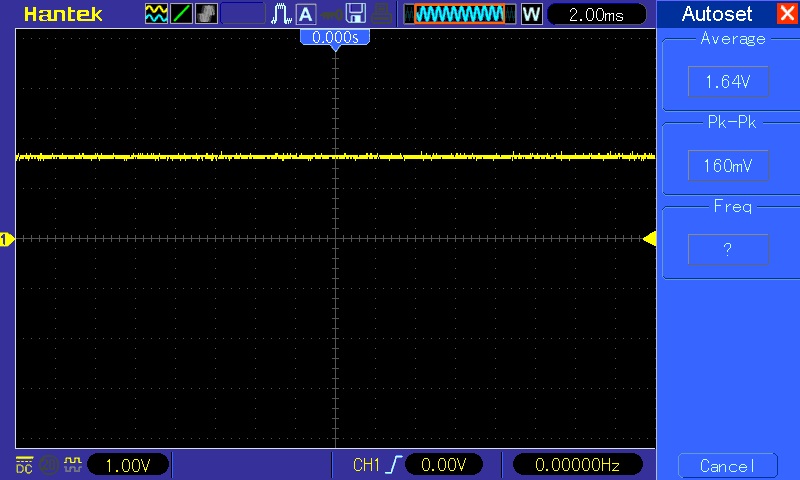
I removed it and the its VCC pin was stuck on PCB detached from the package due rust corrosion:
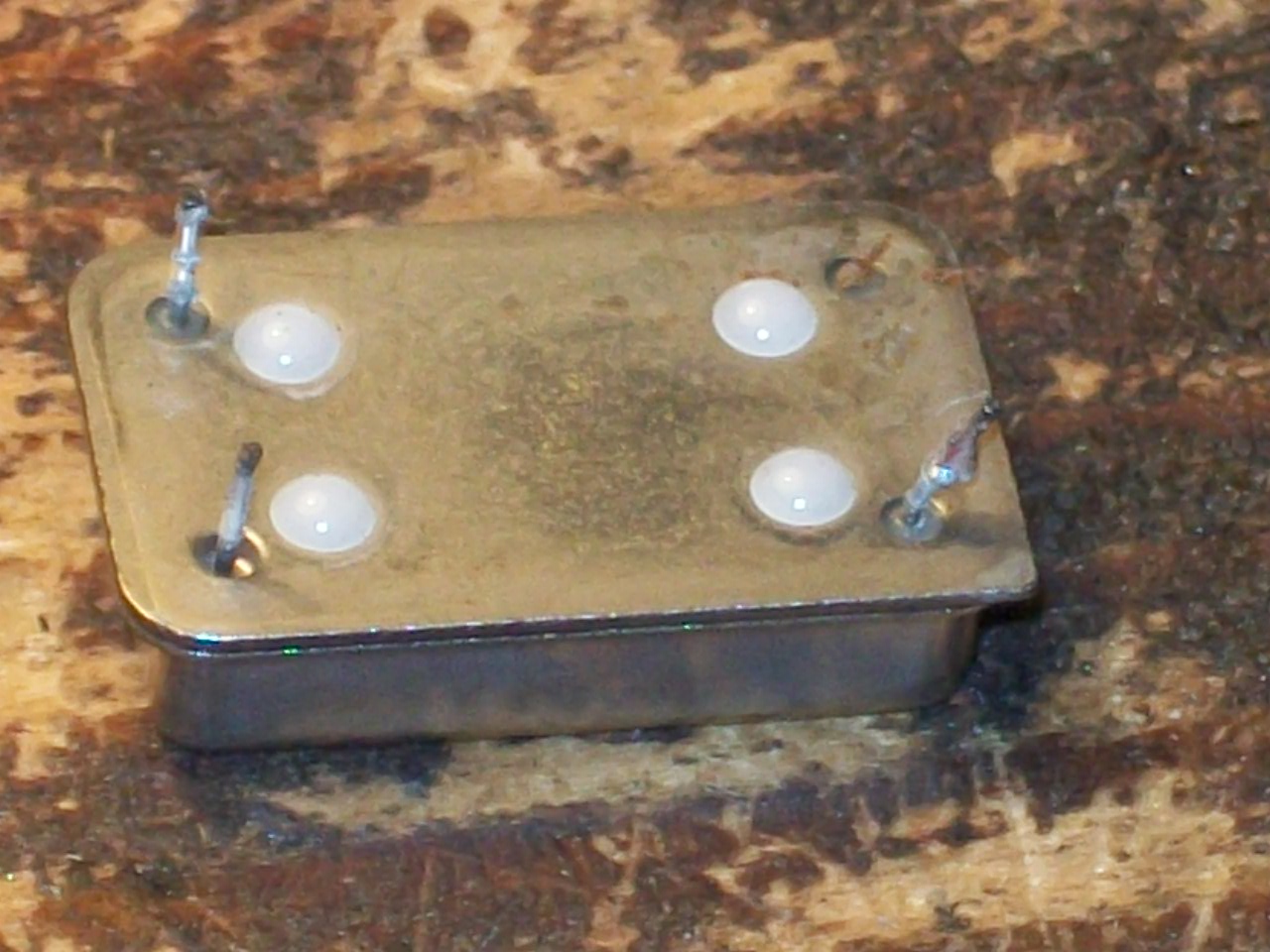
Fitted a good oscillator and board sprang to life although with bad graphics:
Doing a visual inspection I found four empy sockets, according to the MAME source PCB layout and pictures on the Net they had to accomodate four TC51832 32K x 8-bit pseudo-static RAMs besides the other four present:

Once fitted the four missing RAMs most of graphics were correctly displayed but sprites were absent :
The sprites are generated by the PGA custom ‘TZB315’ (see picture above) so I went to probe the surrounding area and found discrepancies between inputs and outputs of some 74ALS245 which are in the middle of ROMs and custom data bus:

I replaced them and, although they resulted good when tested out-of-circuit, I got sprites back although scrambled :
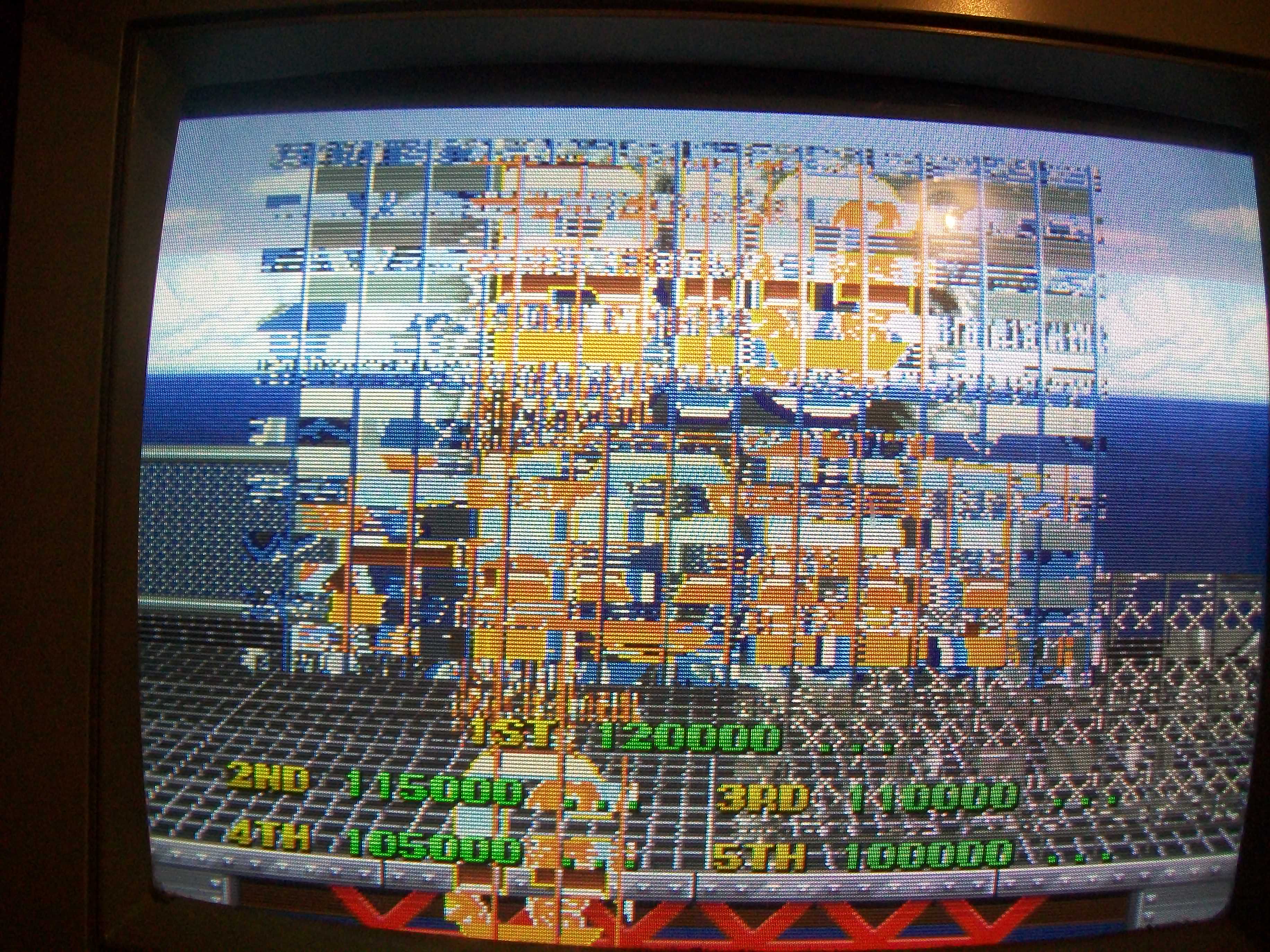
Sprites data are stored in eight 4Mbit 32 pin EPROMs:
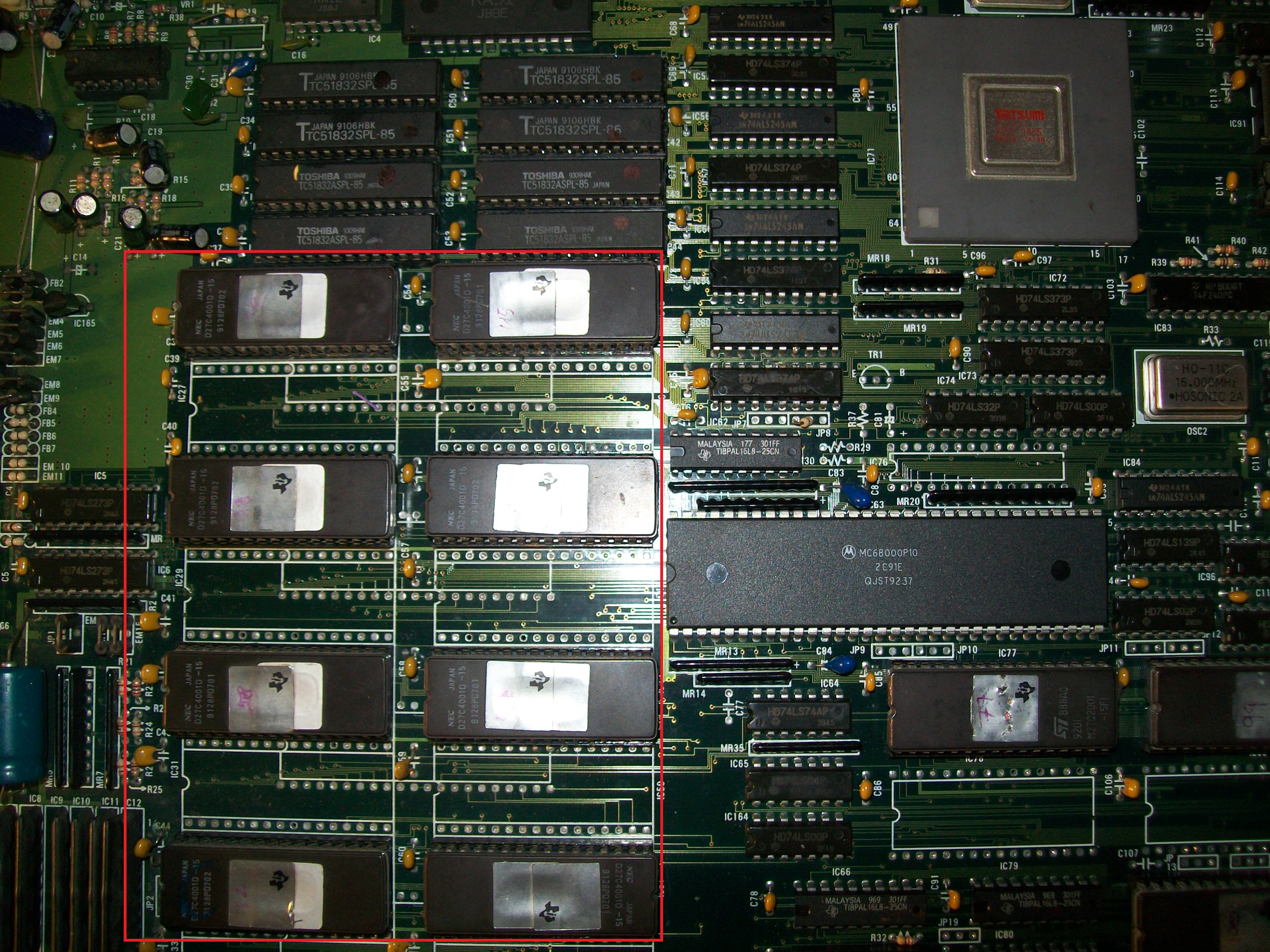
I dumped them and they matched the MAME ROM set but I noticed some of them had oxidized legs:
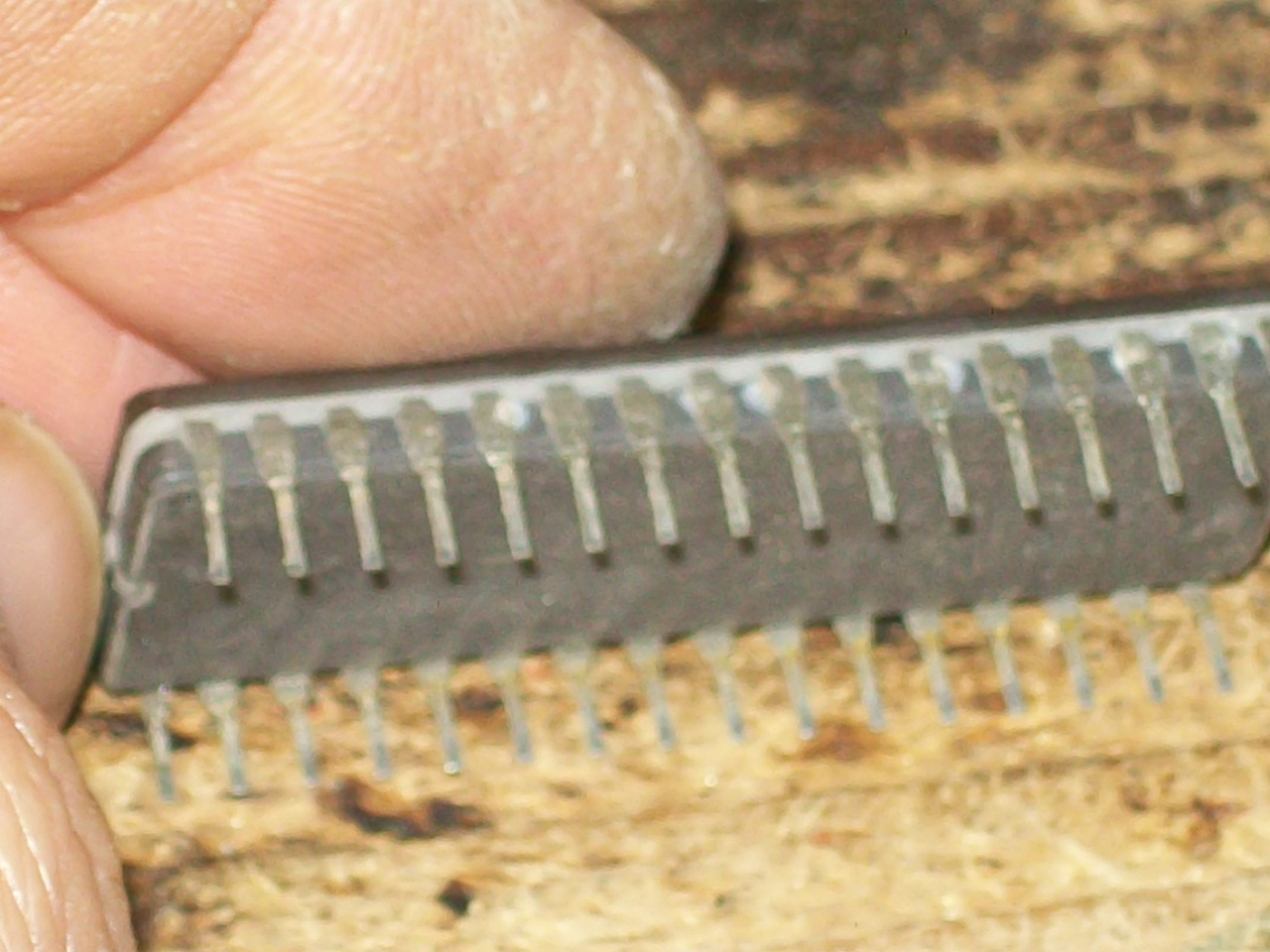
I cleaned them and at same time replaced a device with a dodgy pin:
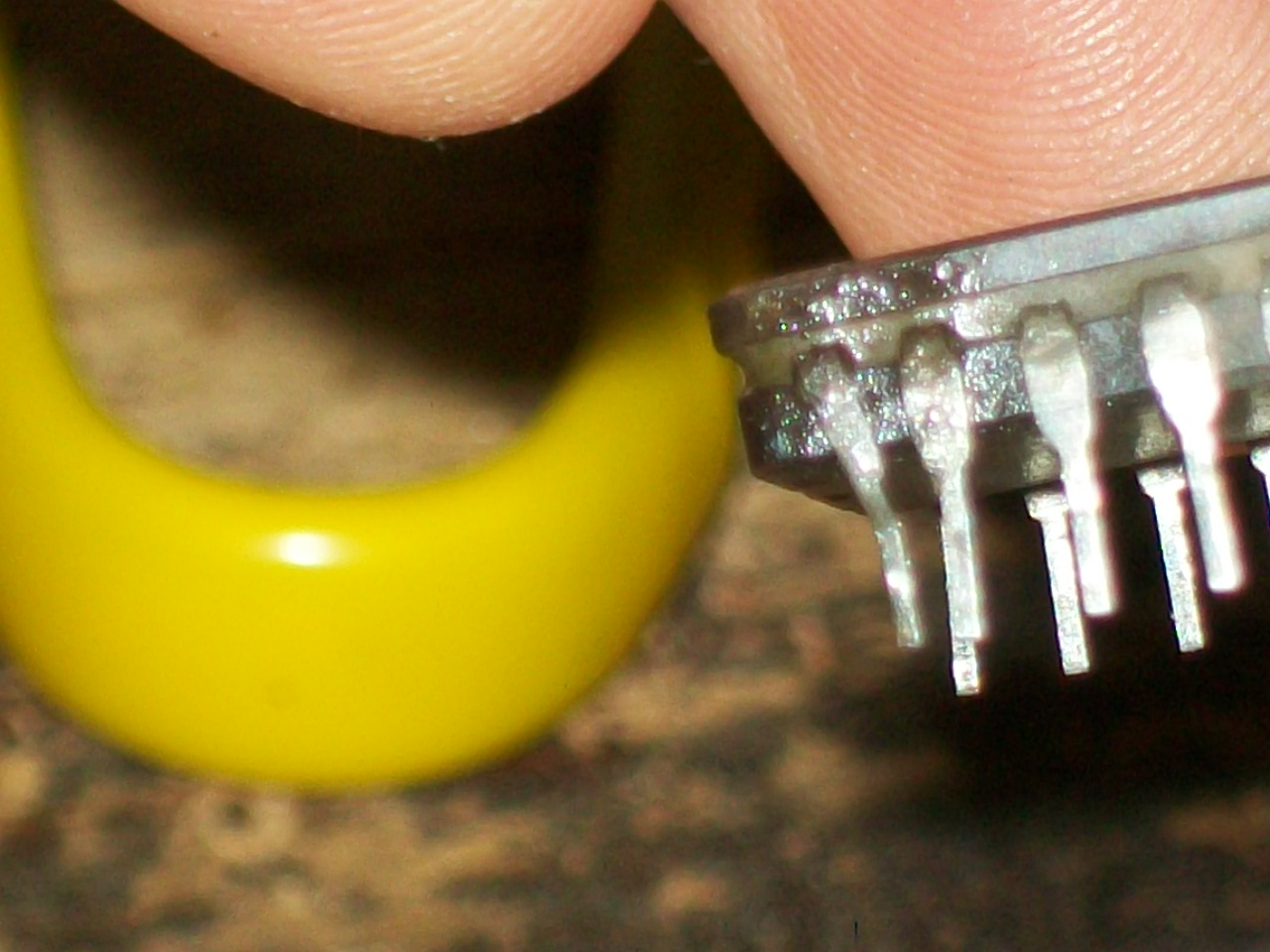
This fully restored sprites:
But as you can see (or better, hear..) in the above video, sound was sometimes noisy and some voice samples were missing (like helicopter when you start a game or voice of special moves and enemies).
Here a recording from a working PCB for comparison:
The background noise was due a dirty 50KOhm potentiometer, I removed and sprayed it with a contact claner :
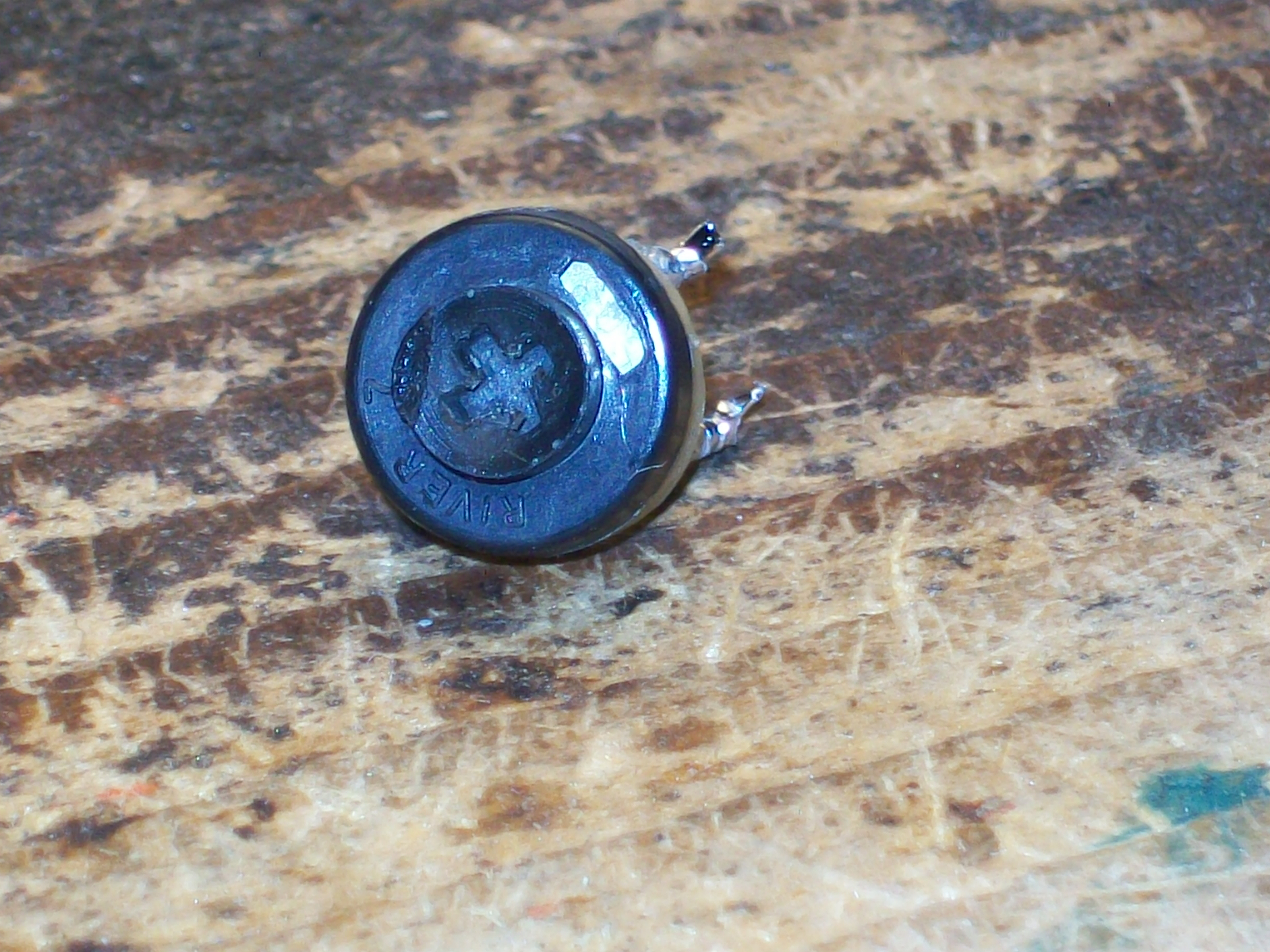
Voice data are stored in a 2Mbit EPROM and played by an OKI MSM6295 (corean rebadged one on this PCB)
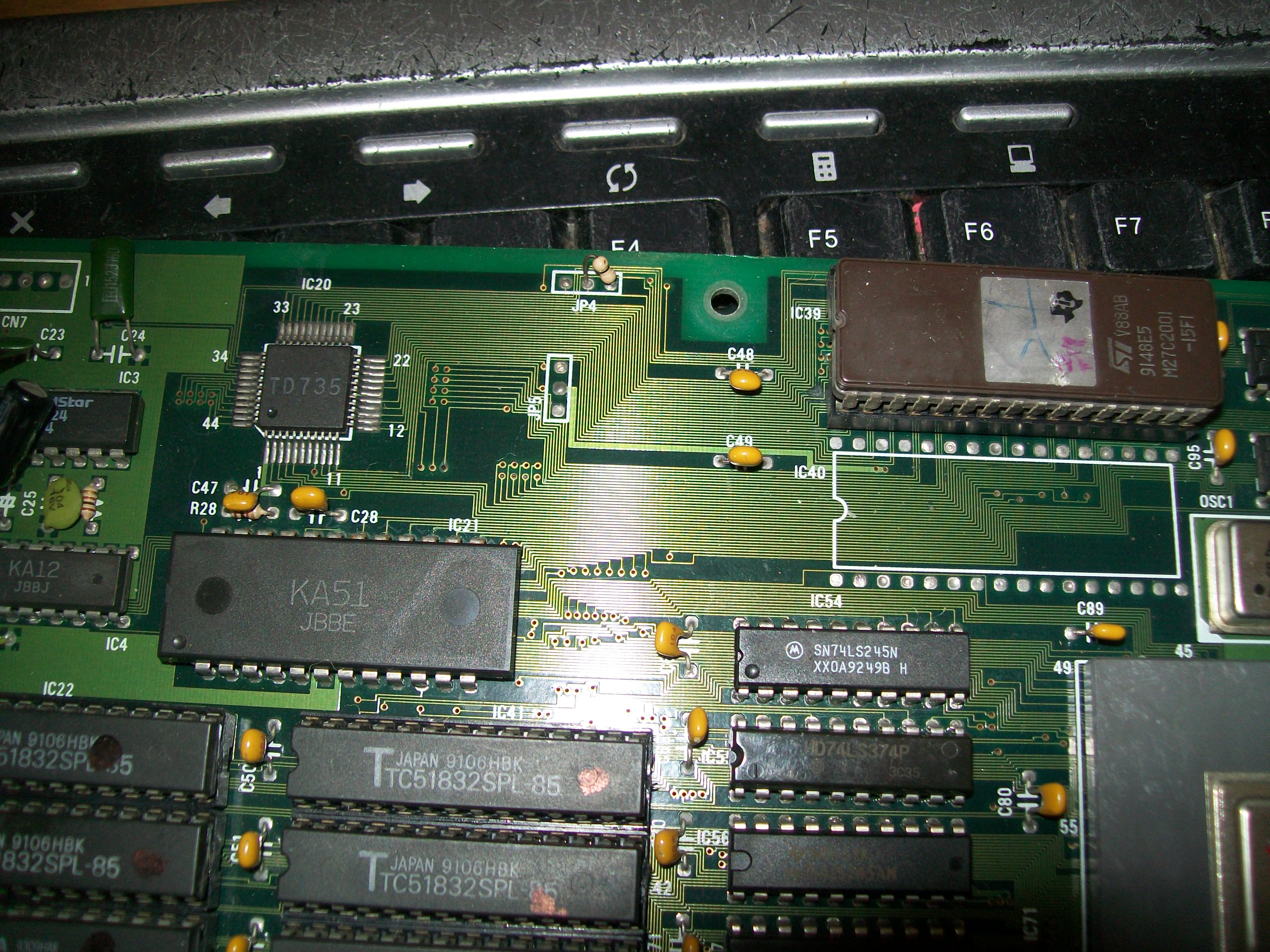
The dump of the EPROM was good, I also replaced the OKI with no luck.Probing the EPROM revealed that pin 30 (address line A17) was always LOW so the second half of the voice data could be not accessed.Doing a check with my multimeter revealed thas this pin was tied to pin 22 (/CE), this obvioulsy sounded me weird.Near the EPROM there was a jumper installed @JP4:
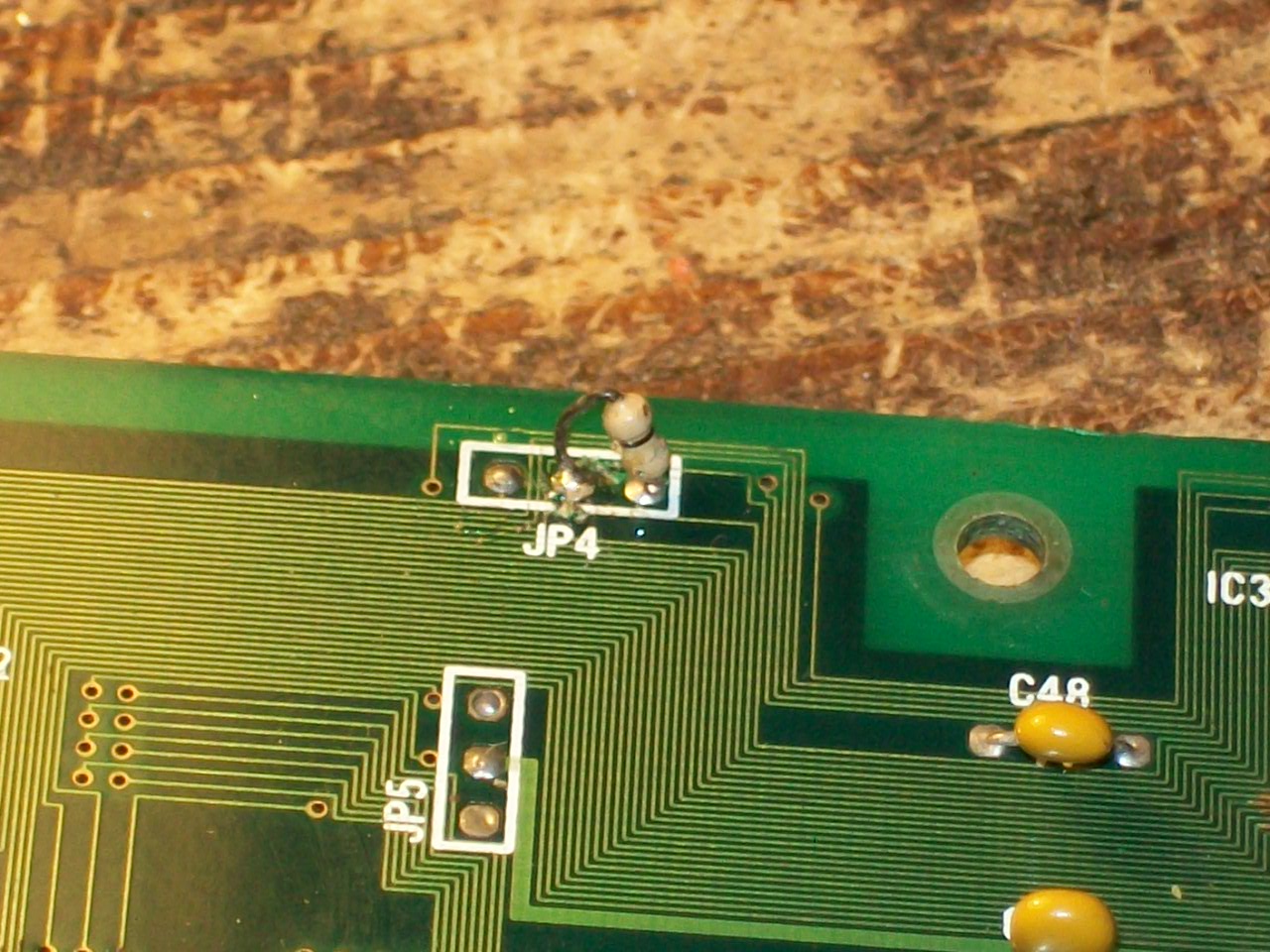
Looking at PCB pictures on the net I had confirm that the jumper had to be set in this configuration.But looking at its solderside I noticed a trace which connected the central pad to the left one.This obviously, along with the jumper installed in that position, caused the short between the left and right pad resulting the two signals being tied together.So, I cutted this trace:
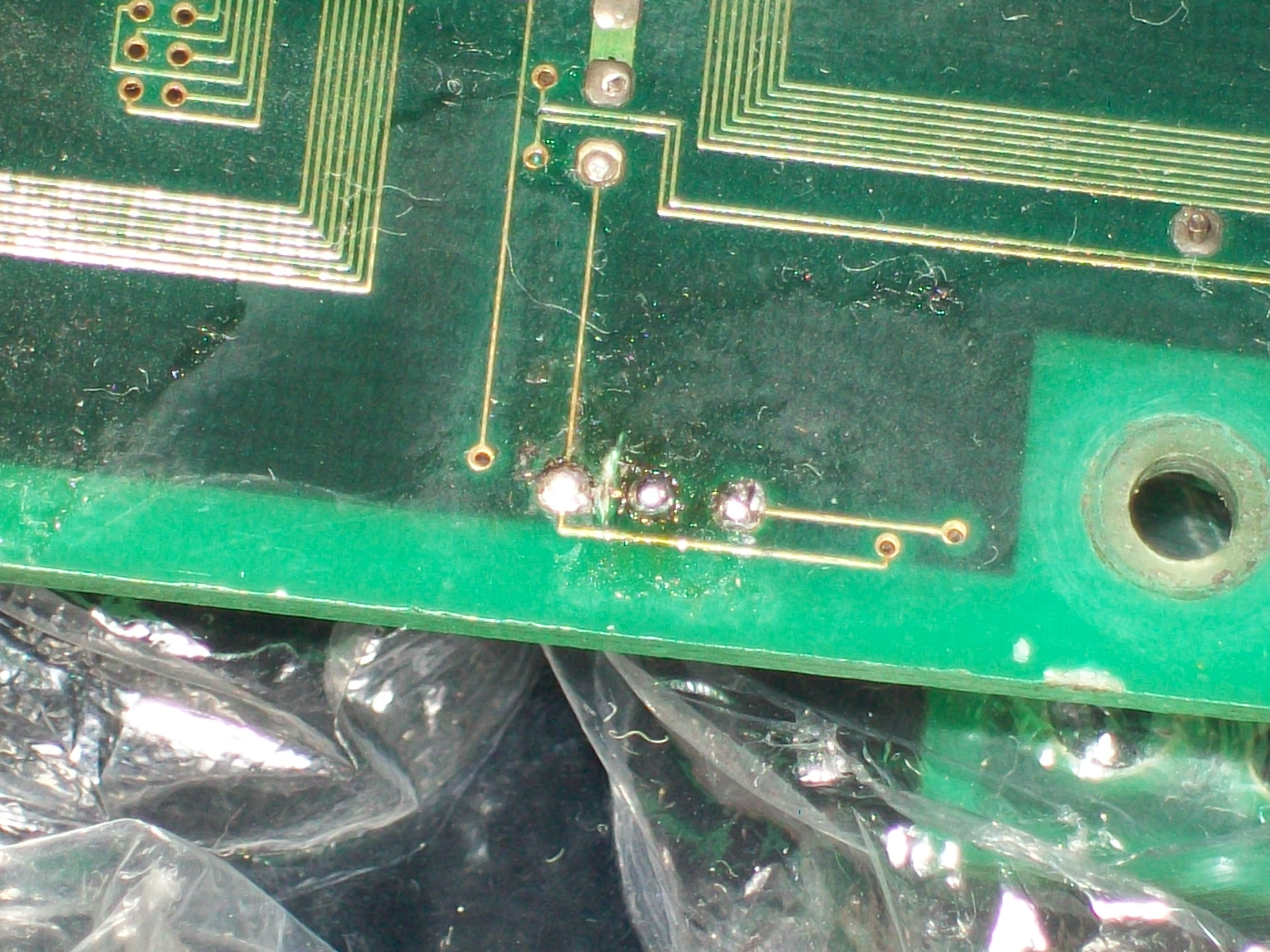
This restored the missing voice samples.No further issues were found so board 100% working.
Big Bang – Power Shooting repair log
I had on the bench this Big Bang – Power Shooting PCB (also known as Thunder Dragon 2)
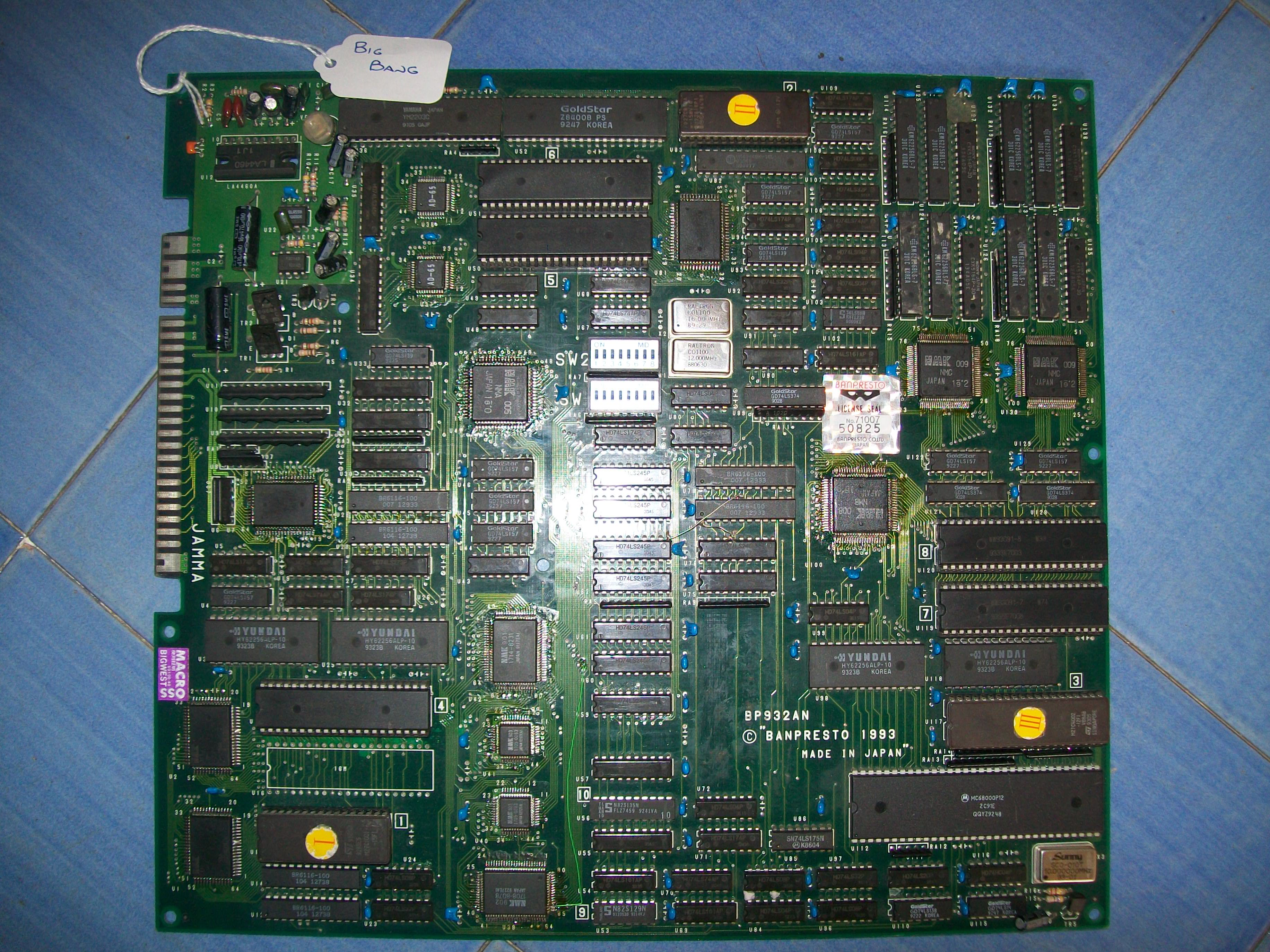
When powerd up it played almost blind, no graphics were displayed:
MAME source reports two devices containing the foreground and background tiles graphics data :
ROM_REGION( 0x020000, "fgtile", 0 ) ROM_LOAD( "1.bin", 0x000000, 0x020000, CRC(d488aafa) SHA1(4d05e7ca075b638dd90ae4c9f224817a8a3ae9f3) ) /* 8x8 tiles */ ROM_REGION( 0x200000, "bgtile", 0 ) ROM_LOAD( "ww930914.2", 0x000000, 0x200000, CRC(f968c65d) SHA1(fd6d21bba53f945b1597d7d0735bc62dd44d5498) ) /* 16x16 tiles */
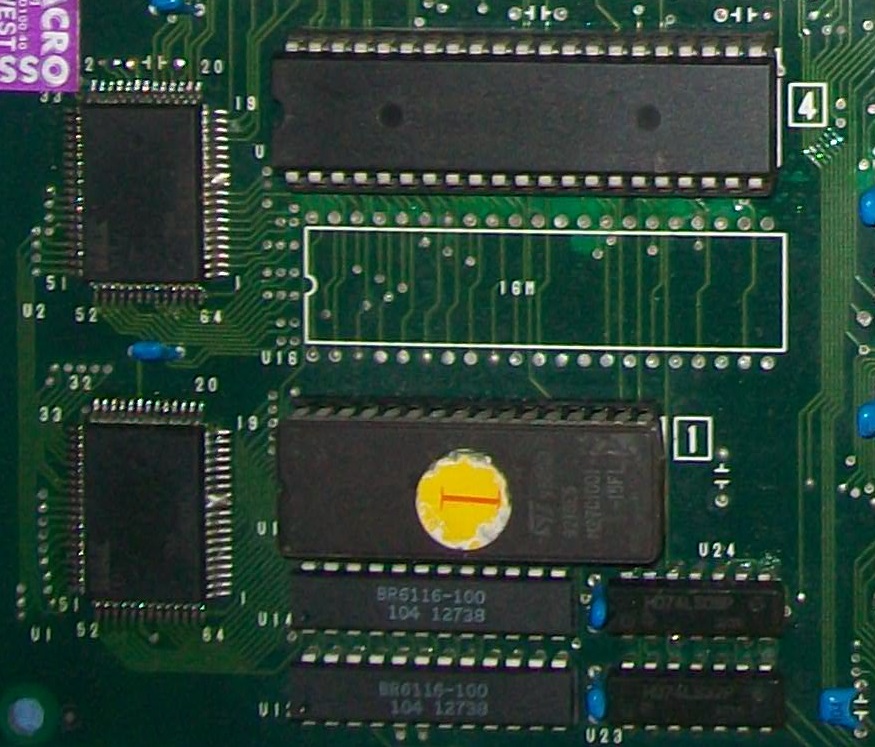
My programmer warned me about a bad contact of pin 32 (VCC) when dumping the EPROM labeled ‘1’ U15 which store foreground data, most likely the +5V wire bond was detached from package:
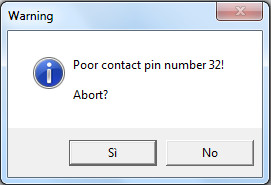 :
:
Replacing the bad device with a programmed 1Mbit EPROM restored all graphics but some garbage were present on screen:
I promptly fixed this issue reflowing some of the surface mounted ASICs.At this point graphics were almost good except for some foreground objects which had wrong colors (bleeding too in some parts).Here is a comparison with MAME snapshot on the left:
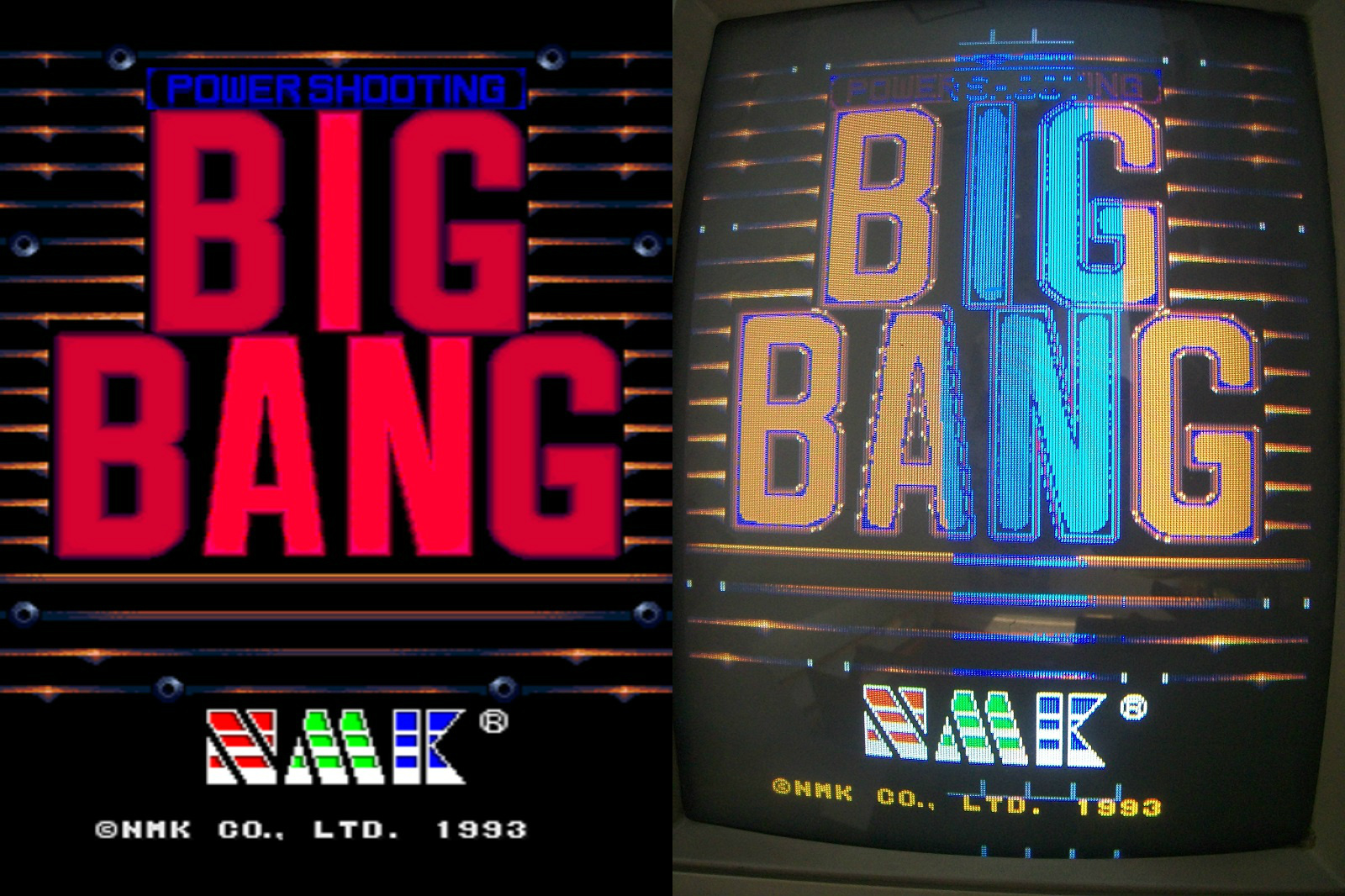
and in details some of the affected objects (MAME snap always on the left):
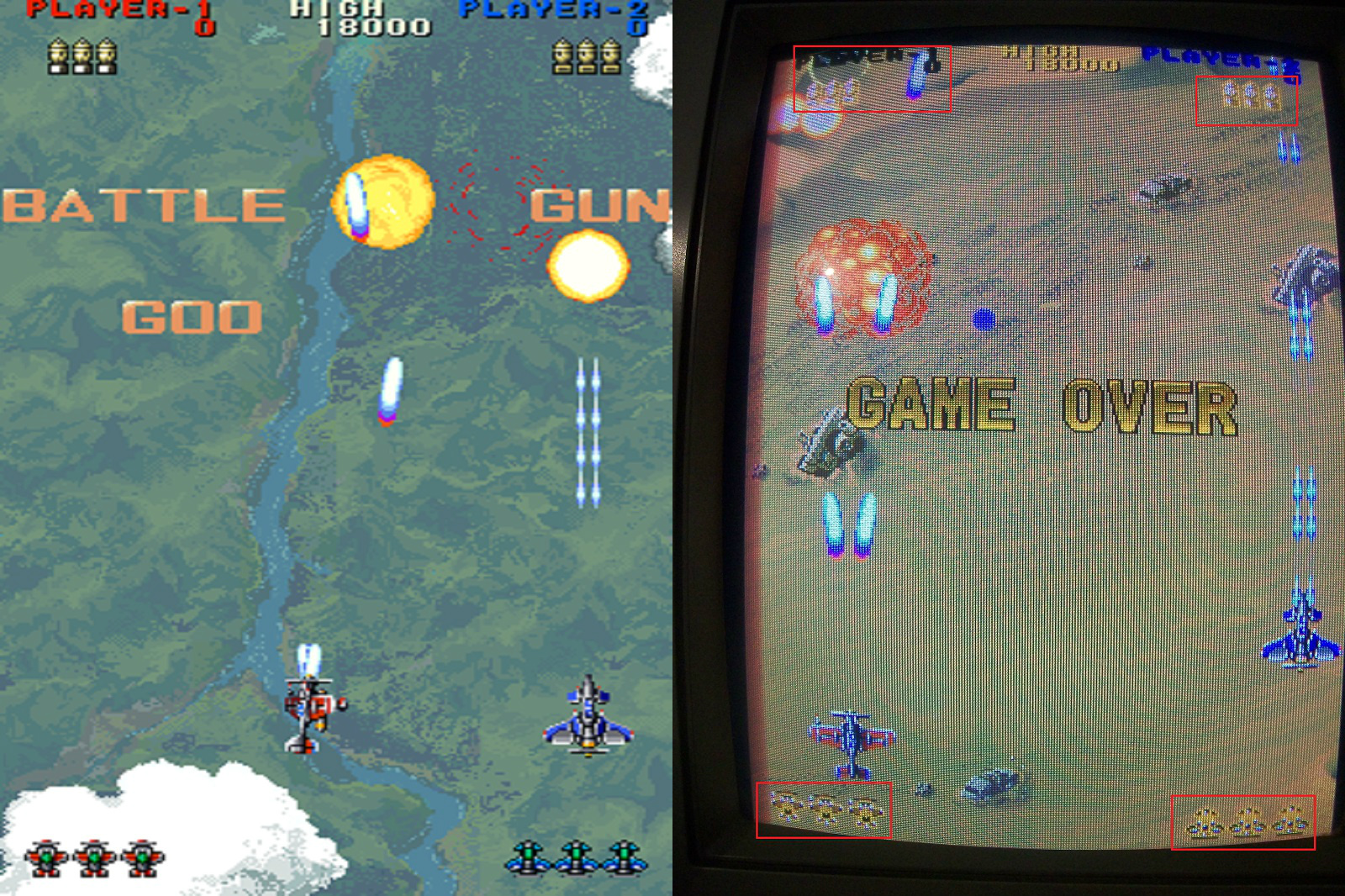
At this point I spent some time to understand how hardware works but, honestly, due total lack of documentation, it was a trial and error.I replaced some of the surface mounted customs until I caught the culprit :
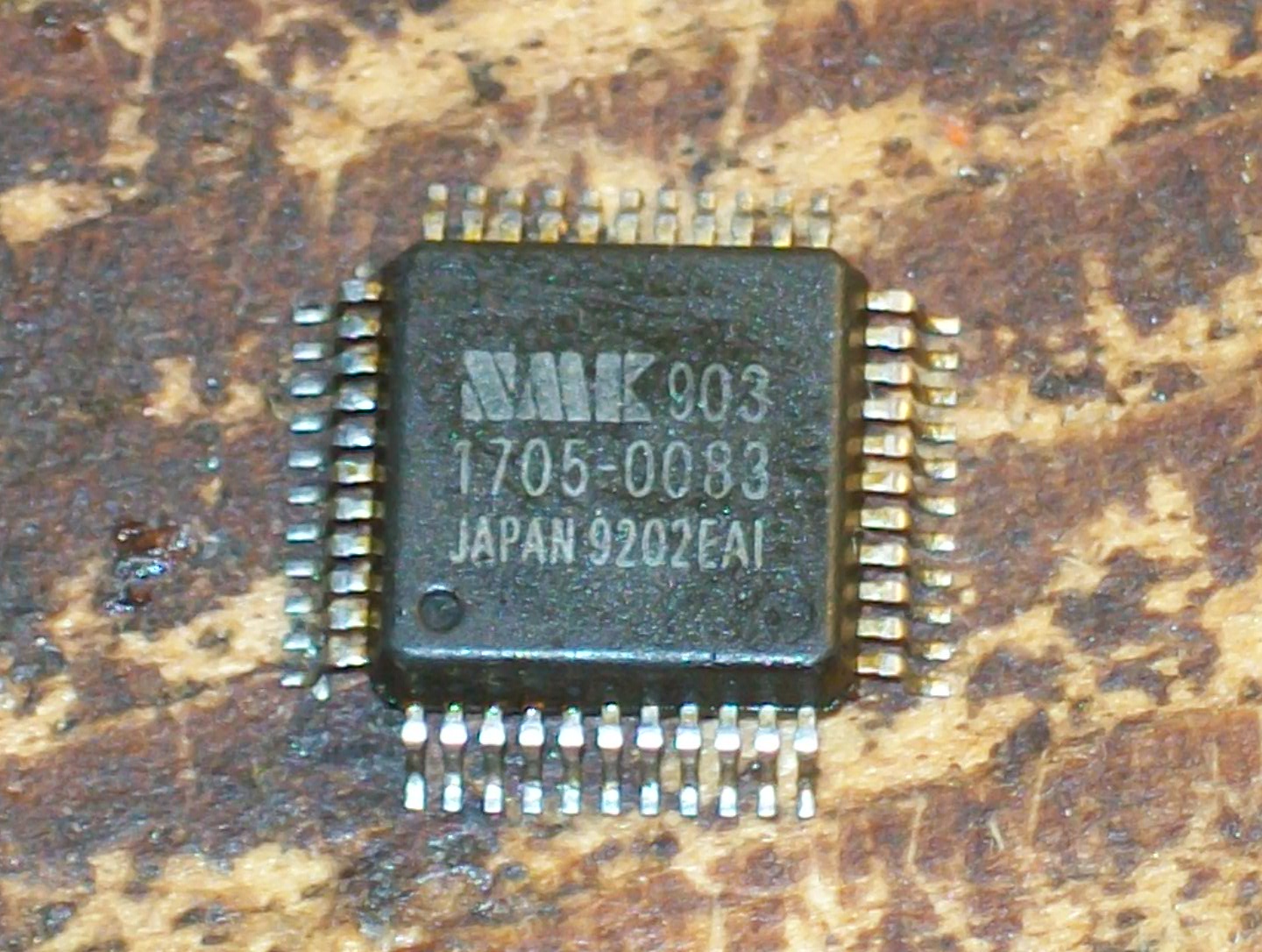
Replacing it (spare part was taken from a dead Hacha Mecha Fighter PCB) restored correct graphics:
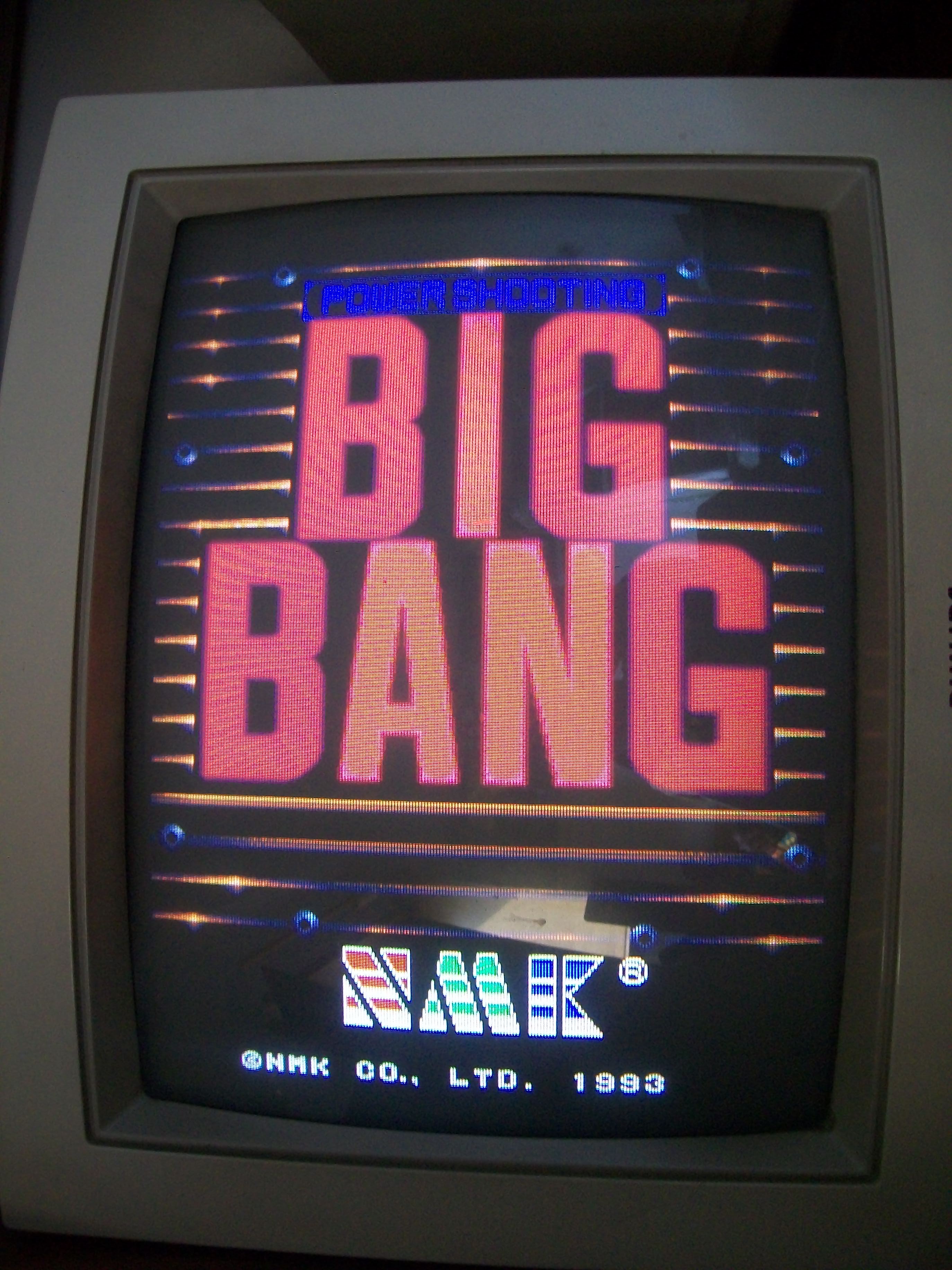
There is an explanation : this ‘NMK 903’ custom is connected to data bus of the 1Mbit EPROM containing the foreground GFX data which was faulty too.So most likely there was a chain failure hence one IC went bad and took out the other (not sure which one for first).But this few matters, another game successfully repaired!
